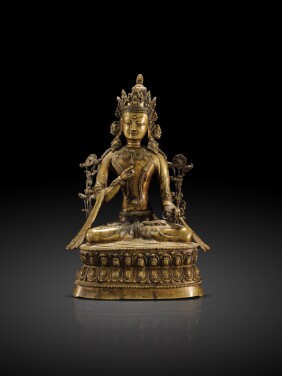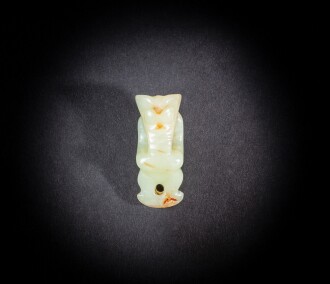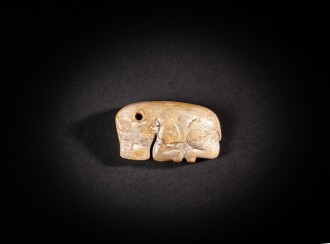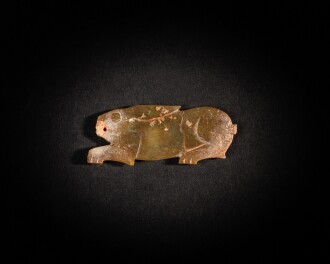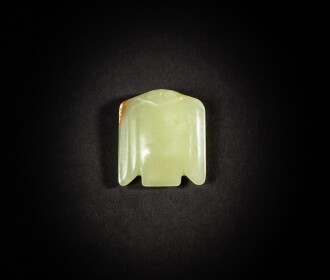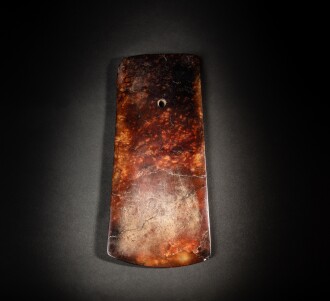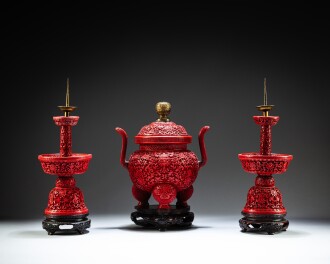T his season’s sale encompasses Buddhist art, archaic jades and bronzes, Song ceramics and the art of the literati. It features a carefully curated section of the Art of the Himalayas highlighted by an impressive 14th – 15th century thangka from Tibet; and the Max Maxwell collection of thokcha, arguably the most comprehensive group ever assembled in this category. A European collection of early ceramics, archaism and furniture well contributes to the Literati aesthetic chosen for this auction; while a selection of the personal collection of Sam and Myrna Meyer in Paris forms the center part of the archaic jades section. Two vividly coloured paintings by Lin Fengmian, of the rare ‘Fishermen’ series on the 1940s, provides another focus to this sale.

Buddhist Art

The Max Maxwell Collection of Thokcha Tibetan Talismans in Primordial Metal John Vincent Bellezza Ph.D.
The inimitable Max Maxwell assembled one of the most interesting and alluring arrays of ancient objects from Tibet ever to appear. Mr. Maxwell, a former art director of Queen and Vogue magazines, artist, poet, and epicurean travelled the world for three decades in search of thokcha, personal bronze objects that are reputed by Tibetans to possess healing and protective powers. Made to be worn on the body or attached to ritual instruments, thokcha come in a multitude of guises, each more curious than the next. Besides their age, beauty and reputed extraordinary qualities, one of their great charms is that they manifest in an astounding variety of human, animal, symbolic, and geometric forms. Formed by close contact with the body over many generations, these copper alloy amulets are often smooth as butter and have acquired a rich, lustrous patina, imbuing them with a sacred aura.
Highly valued by Tibetans for their magical properties, thokcha were traditionally handed down from parents to their children and grandchildren or passed on by spiritual masters to their disciples, in family, clan and monastic lineages that sometimes stretched on for centuries. The word thokcha is made up of two Tibetan terms: thog meaning ‘primordial’, ‘thunderbolt’ or ‘lightning’, and lcags which translates as ‘iron’ or ‘metal’ in a more generic sense. Thus, thokcha signifies ‘primordial metal’ or ‘thunder iron’. These two definitions are not as different as they might seem at first, because Tibetans believe that thunder and lightning are primal forces of the cosmos that helped give rise to all lifeforms. The etymology of the word thokcha is closely tied to the mythology that surrounds these objects. The most popular tale told in Tibet is that when lightning hits the ground it reacts with earth and water to produce thokcha. A more colorful story has it that when celestial dragons emit thunder, they release thokcha from their mouth. It is also said by Tibetans that thokcha were forged by the divine blacksmith Garwa Nakpo, or were produced in ancient times when warring magicians attacked one another with supernatural hail.
No other class of material objects is as emblematic of Tibetan civilization as thokcha. Art-historical and ethnographic surveys of these curious metallic objects indicate that they originally had many different purposes. Some were cast expressly to be used as amulets (srungkhor) against misfortune and to increase the good fortune capacity (yang) of individuals. Other thokcha were made as sectarian, occupational and genealogical badges. Many though represent ancient tools, eating utensils, ritual implements, ornaments, and military insignia, among other things. There are two main divisions of thokcha, those attributed to the late prehistoric era (circa 1200 BCE to 600 CE) and those that date to historic times (post-600 CE). Both divisions contain a wide range of objects including human and animal figures, geometrics and sacred symbolism. Most highly prized by Tibetans are thokcha that depict Buddhist deities, symbols and inscriptions. Those presenting Buddhist themes first appeared in Tibet in the 7th and 8th century CE and continued to be fabricated for many centuries. Among the best-known personalities represented are Vajrapani and Avalokiteshvara, the bodhisattvas of skillful means and all-embracing compassion respectively. The horned eagle (called khyung in Tibetan), lion, makara (a crocodyloid creature) and turtle are four of the most famous zoomorphic icons and have both Buddhist and pre-Buddhist iterations. These creatures are viewed as divine protectors and as wearable items that may have served as clan totems and martial symbols in the distant past. Popular non-animate categories of thokcha include flowers, endless knots, flaming jewels, discs, and spoked wheels.
Nowadays, if one scrutinizes items for sale in the marketplaces of Tibetan cultural regions and mainland China, it would be no exaggeration to state that more than 95% of supposed thokcha for sale are modern reproductions. The collector Max Maxwell had the distinct advantage of amassing his horde of miniature treasures from the 1970s to 1990s, when there were far more authentic pieces on offer. More crucially, his intimate knowledge of the medium and constant vigilance gave him the coveted ability to discern the authentic from modern-day knockoffs. Hence, the integrity of the Maxwell collection is unimpeachable.
It is hard to choose among the many excellent examples in it but let us examine a few thokcha individually. In fig. 1 we see a very fine example of Vajrapani made for wearing on the body (there is an attachment loop on the back). In the right hand the deity wields a vajra (thunderbolt), the symbol par excellence of tantric Buddhism. In Tibetan, the vajra is called the ‘lord of stones’ (dorje).
The beautifully formed thokcha in fig. 2 combines quintessential symbols of Tibetan Buddhism, the vajra, triple gems and probable sun and moon (lower two rings), in an ensemble laden with religious meaning and pious observance. This talisman was intended to be displayed on the body. The goddess Vajravarahi in fig. 3 was superbly modelled and cast. This divine female figure is one of the major tantric protectresses of Tibet.
She is recognizable by the sow’s head that emerges from her crown consisting of five diadems. She is attired in a scant girdle and dons a garland of human heads. This figurine was designed to be enshrined, possibly in a gau, the reliquary boxes that Tibetans have traditionally carried with them.
The attachment loops on the rear of this finely detailed and unusual khyung (fig. 4) demonstrate that it was made to be suspended from the neck or otherwise attached to the body. Emerging from either side of the eagle’s head are makara heads, a creature associated with the watery realm. It is believed by Tibetans that the khyung and the makara control the ubiquitous water spirits known as lu.

The thokcha in fig. 5 is a typical example of the zoomorphic iconography that existed in Tibet before the advent of Buddhism. The cultural and religious traditions of that time are generally called bon by Tibetans (not to be confused with the more recent Buddhist-like Bon religion).
The frog is a symbol of the underworld or aquatic realm, matrilineal traditions and the divine guardians of females. The tiger acts as a warrior god associated with the terrestrial realm, and the endemic wild yak is the most distinctively Tibetan of animals. While the functions attached to such animals in the historic era cannot be transferred wholesale to earlier periods, they supply us with some idea of how the three animals may have been perceived in Tibet’s Protohistoric period.
The thokcha in the shape of a boar in fig. 6 was designed to be worn on the body. The artistic and religious inspiration for this early bronze object came from northwest China and other parts of Inner Asia in the Iron Age, where the boar is well accounted for in various media given over to the Eurasian animal style. The reliquary box in fig. 7 proudly displays the most popular Tibetan wealth deity, Dzambhala. This divinity sits astride a horse and holds a jewel in one hand and the wealth-bestowing mongoose in the other. Such objects were customarily filled with relics, sacred substances and images, and holy texts. Fig. 7. A reliquary box (gau) fashioned from brass and bronze featuring an engraving of the wealth god Dzambhala on the front.
I first met Max Maxwell in the early 1990s in Kathmandu. We ran into each other in an out-of-the-way antique shop in the old city. I was quite surprised to see another foreigner there. One could only be impressed by Max’s refined bearing and delicately accented English. He was a raconteur belonging to the old school and one with a mischievous sense of humour. No sooner had we met when he pulled out some thokcha and laid them out on the counter. Turning to me he said, “which ones are real and which are fake, you tell me”. Passing that test, I was worthy enough to see what Max had in stock. I was stuck by the beauty and quality of the objet d’art he had procured from all over Tibetan cultural regions and in mainland China and Hong Kong as well.

Max explained that he had combed the markets of Labrang, Zoige, Songpan, Chengdu, Kanding, Litang, Zongdian, Lijiang, Dali, and Kunming, etc. The complex logistics aside, this was no mean feat, for many local dealers were wily, even aggressive merchants. Once the money left your fingertips a deal was considered finished, whether one had been duped or not by the sales pitch. Over the years, Max showed me one beautiful and unusual piece after another, always commenting intelligently on their age and rarity. Although he was clearly addicted to thokcha, Maxwell was no staid collector. This savvy businessman knew how to enjoy the best in life, living in a simple yet elegant manner in some of the most beautiful places on earth. After quitting his job as an art director of high fashion magazines in London during the swinging mid-1960s, he moved to a fortified farmhouse built in the 1300s that overlooked the Mediterranean Sea. Later, he would winter on the beach in Goa, the Philippines or Thailand. Writing of his summers in Ladakh, Maxwell describes his accommodation in glowing terms: ‘I lived in a traditional farm house at 12,000 feet, with spectacular views of snow crowned peaks and the Indus River valley, I bath in a beautiful glacier-fed stream running through fields of barley and stands of poplar and willow trees.’
Despite all that we know about thokcha, there are still many mysteries surrounding them that have yet to be solved by scholars. Central are questions concerning precisely where and when they were made. In many cases, their specific cultural uses and significance also remain enigmatic. Archaeological research carried out in Tibet reveals that simple copper objects were probably being created on the Tibetan Plateau by around 1500 BCE. Circa 700 BCE, the production of bronzeware expanded greatly in Tibet, giving rise to many classes of objects that Tibetans now call thokcha. The first person to carefully study them was the celebrated 20th century Italian Tibetologist, Giuseppe Tucci. His 1935 article, “On Some Bronze Objects Discovered in Western Tibet” and his book, The Ancient Civilization of Transhimalaya” published in 1973, are still required reading on the subject. Recently, western archaeologists have discovered copper alloy objects in Mustang, Nepal, which date from between 1400 BCE and 600 CE. Some of these Mustang finds are no other than what Tibetans refer to as thokcha. Chinese archaeologists working in Guge in western Tibet in the last quarter of a century have also unearthed thokcha from tombs, which range in age from circa 500 BCE to 400 CE. Max Maxwell and I collaborated on an article about some of his thokcha published in Asian Art Online Journal entitled, “The Ancient Amulets of Tibet” (1999). He also coauthored a handsomely produced art book on thokcha with Tony Anninos around 2003, which is called The Ancient Amulets of Tibet: A Private Collection of 108 Miniature Masterpieces (fig. 8). However, Maxwell was by no means an armchair collector: he single-handedly amassed one of the world’s greatest collections of thokcha by combing nearly all corners of the Northern Hemisphere. An inveterate traveller, he shuttled back and forth between Asia, Europe and North America in his search for these intriguing little pieces of ancient metal. Maxwell reports first encountering thokcha in the late 1970s in Ladakh, a Tibetan cultural region located in northwestern India. He was deeply impressed by Ladakh and its people and culture and wrote about his experiences there in a brief memoir that appeared in the Asian Art Online Journal: ‘I entered the magical world of shamans, oracles, exorcists, amchis, and Tibetan folk fantasies, when I started collecting thokcha in Leh, capital of the ancient Himalayan kingdom of Ladakh. In those days Ladakhis all wore theatrical hats and chubas, ankle length coats with scarf like belts, the women wore peraks, fabulous turquoise headdresses which contained the family wealth. Schools were held under willow trees and money hardly existed. When the first trucks arrived in Leh, the inhabitants brought out hay to feed them.’
The 380 thokcha offered here, most of them published in Tony Anninos book in 2003, form arguably the finest and most comprehensive collection in this category ever assembled. It well illustrates the great passion Max Maxwell developed for the ancient art of Tibet and the Himalayas over the years. After carefully preserving the collection since Max sadly passing away in 2005, his family decided that it was now time to part with it, and leave to others the chance to enter the magical world of shamans.

Read Less

Archaic Bronzes and Jades

Archaic Jades from The Personal Collection of Sam and Myrna Myers in France

Two Rare Paintings by Lin Fengmian


